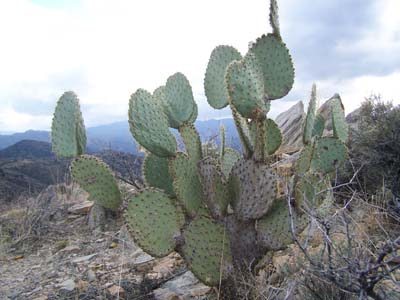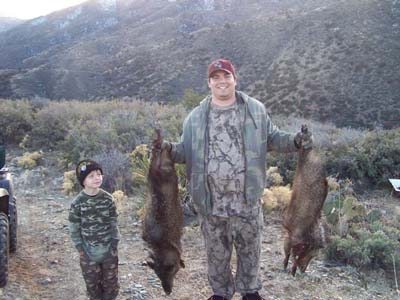This Adventure On a Budget is what DIY dreams are made of. It’s an American Safari to Arizona in pursuit of the exotic, “collared peccary.” A mid-winter Javelina hunt in Arizona is perfectly timed to provide a most pleasing way for hunters to break the chains of cabin fever. A week afield in sunny Arizona will give needed relief from the winter doldrums no matter where you live. Javelina are the aristocracy of this swine type species and are hunted as big game in the southwest. Center-fire hand guns or rifles are required. A nice side bar in the Javelina hunt is the array of weapons you have the chance to use. The Hornady .17 Hornet, 20gr V-Max is a nice center fire round. The .204 is another viable, fun round. Many hunters use some form of the .223 in a bolt action or on an AR platform. A few use the .223 in pistol size as a different approach to hunt Javelina. In other words, you can leave the heavy artillery on the shelf for this southwestern Safari. Of course, primitive weapons including archery related items, along with muzzleloaders and handguns, have special hunting opportunities during the Javelina season.
 Javelina have a telling musky order, similar to that of a bull elk, but more obnoxious, so in this case, our limited sense of smell can be an asset on a Javelina hunt. All Javelina have tusks for rooting, shredding Prickly Pear Cactus and defense. They have the instincts of a bird dog and when they feel something isn’t right, the entire herd will stop mid-step and hold their position frozen like a champion bird dog on point. They will assess the threat of danger, largely by their keen sense of smell, since their eye sight is poor. Once they are on high alert in frozen positions, they will likely bolt. After flushing like a covey of quail, they gingerly use their propensity for disappearing and do so right before your eyes. The normal size of a herd is in the single digits, but double digit herds are sometimes seen. If you see a single Javelina, take your time and glass because they are a herd animal, so others may be nearby.
Javelina have a telling musky order, similar to that of a bull elk, but more obnoxious, so in this case, our limited sense of smell can be an asset on a Javelina hunt. All Javelina have tusks for rooting, shredding Prickly Pear Cactus and defense. They have the instincts of a bird dog and when they feel something isn’t right, the entire herd will stop mid-step and hold their position frozen like a champion bird dog on point. They will assess the threat of danger, largely by their keen sense of smell, since their eye sight is poor. Once they are on high alert in frozen positions, they will likely bolt. After flushing like a covey of quail, they gingerly use their propensity for disappearing and do so right before your eyes. The normal size of a herd is in the single digits, but double digit herds are sometimes seen. If you see a single Javelina, take your time and glass because they are a herd animal, so others may be nearby.The bolting or busting up of a herd can work in the hunter’s favor. The action and drama of the herd heading in many directions may confuse some members of the herd. If you find yourself in the position of walking into a herd and busting them up, watch where they head, but hold your position. Many times a confused Javelina or an old boar will depart after the mass exodus of the main herd. This may give the hunter a shot opportunity. If a shot opportunity does not present itself, then find a good glassing point and glass the area the herd headed for. This is one of the many challenges of Javelina hunting.
One minute the Javelina herd may be well within range, then bolt or drift over the next rise in elevation to not to be seen again. If you are glassing a herd and they drift out of sight, then take a break. Hunt another area if you have the time, then return to where you left them and approach from a different angle and direction. From this different approach point, pick a good glassing spot and scan the area. You would be wise to have chosen this good glassing spot before you made the decision to leave your original position and come back later. A herd of Javelina will often return to a good food source. Remember too in the desert environment, water is a critical factor in the hunt. Do not over-look riparian areas as they usually have water sources.
After glassing with no sightings in the spot where you first spotted them, consider moving into that area. Stalk carefully down to the area where you spotted the Javelina. Once to the spot, take your time and check for fresh sign. Look for rooted up cactus, mainly Prickly Pear and shredded pads from the Prickly Pear plant. Use your nose, smelling for that musky scent. Javelina tracks are very small as are their droppings. However, they make a mess of the Prickly Pear where they are feeding. Hillsides full of Prickly Pear are an invitation to dinner for the Javelina.
 Planning and Cost for Licenses
Planning and Cost for LicensesPrior planning for an Arizona Javelina hunt takes place in September and early October of the year before your planned hunt in January or February. If you wish to apply for a specific Javelina hunt area, that can be accomplished online with an application due in early October. There are some OTC tags available - these are called Non-Permit Tags. They are valid for some Arizona Javelina hunting units. No draw necessary, just purchase and go hunting. Either way, a non-resident will be required to buy a Non-Resident Combination Hunting and Fishing license which costs $160.00. Thus, to apply for a Javelina tag, the total cost up front would be $175.00, which includes the $15.00 application fee for applying for a Javelina tag. If you go the OTC route, then there is no $15.00 application fee. Therefore, the total OTC cost to hunt Javelina is $160 plus the $100.00 Javelina tag or $260.00 total. If you apply for the draw hunt for Javelina and get drawn, the total cost to hunt Javelina is $275.00.
For youth hunting under the age of 18, the costs are very low for Javelina hunting. The Non-Resident Combination Hunting and Fishing youth license is $5.00 and $30.00 for a Javelina tag. There of course is the $15.00 application for a draw hunt fee. So, for a youth only Javelina hunt, a non-resident could hunt for not more that $50.00 if drawn and as cheap as $35.00 for the OTC tags. A youth 10 to 13 must have passed their hunter education. The hunting licenses purchased are good for one year from date of purchase. Thus, the non-resident hunter could apply for and if drawn go on other big games hunts in Arizona for one year without buying a new non-resident license. The cost would be only the $15.00 application fee for each hunt applied for plus the cost of the tag. However, if drawn for say an elk or deer hunt, the season drawn for would of course have to fall within your license timeframe or you would have to buy a new license.
Places to Hunt and Lodging Expenses
The Javelina hunt is a real gentleman’s hunt. These little aristocrats prefer outstanding weather conditions for their day-time activities. They love to dine on nice sunny days. Good for the gentleman hunter is the fact that you are as likely to see them in good weather conditions at mid-morning, noon time mid-afternoon as you are at day-break or dusk. So, you don’t have alarm clock worries or concerns about rousting a teenager out of bed or getting a little more shut-eye for yourself. It’s okay to be in the field a little later or a lot later.
The Javelina hunt lends itself to a nice comfortable stay in a nearby motel. Look at the Arizona Game and Fish website for a map showing the distribution of Javelina in the state. You will see that the Javelina distribution flow east, west along the I-40 across the entire state and at Flagstaff all along the I-17 south to Tucson. If you are coming from California, then the same thing is true for the I-8 or if from parts of New Mexico or Texas, then I-10. There is Javelina hunting all around these major highways. Motels abound all along these highway corridors and rates vary, but $50 to $100 a night will usually get you an average type room. If you wish to camp, then that’s easy in Arizona.
Arizona Game and Fish Department provides detailed information about each specific Javelina hunt unit. Since the hunt units are large, they will indicate areas where Javelina are most likely found. Public lands are available for great hunting, but private lands require permission. Just ask ranchers and for a Javelina hunt you will probably get permission to hunt. Also, you might get some information as to where the local populations of Javelina might be located. Forest Service roads are good in most areas and a truck can access lots of Javelina country. Check with the local Forest Service to get updates on any possible road closures. That being said, a 4WD or ATV offers greater access and more fun in Arizona’s very user friendly off-road adventures.
 Diversity in Arizona Is the Norm
Diversity in Arizona Is the NormSand dunes to 12,000 foot mountaintops, with Javelina found on the floor of the Sonoran Desert to places around 7,000 feet in elevation along the I-40 East and west of Flagstaff are all possibilities. Habitat, weather, wildlife and temperatures change with the elevation. So, it is that Javelina share most of their range with elk, three species of deer, bear, lion and bison. A viable sidebar to a Javelina hunt is that it can be used as a vehicle to gather boots-on-the-ground wildlife data on other species in specific hunt areas. This should be of great benefit if you have interest in applying for other Arizona big game adventures on a budget.
Reservation Hunting
Arizona does offer viable Javelina hunts on both the San Carlos and White River Apache Reservations. These two reservations are well known for their outstanding, but pricey elk hunting. They offer, on a first come first serve basis, Javelina tags for about the same price it would cost for a non-resident to hunt in Arizona. For example, on the San Carlos in 2016, it was $280.80 for a Javelina tag. You do not have to draw, but tags are limited in number, so watch their website to see when they become available. Both these reservations are off the beaten path and favor those hunters traveling from the east. San Carlos is three hours east of Phoenix and the White River location for hunting is over four hours to the northeast of Phoenix.
If you opt for a reservation hunt on the San Carlos, hunt around the Gila River and San Carlos Lake. Both of these locations offer easy access and reliable numbers of Javelina. The White River hunt is usually good for Javelina in the southwest corner of the reservation, above the rim of the famous Salt River Canyon. Experience with hunting the reservations is a little on the tedious side as information is more difficult to obtain than you would expect. At the end of the day, if you opt for a state hunt on public land or a reservation hunt, plan your safari as far ahead as possible.

